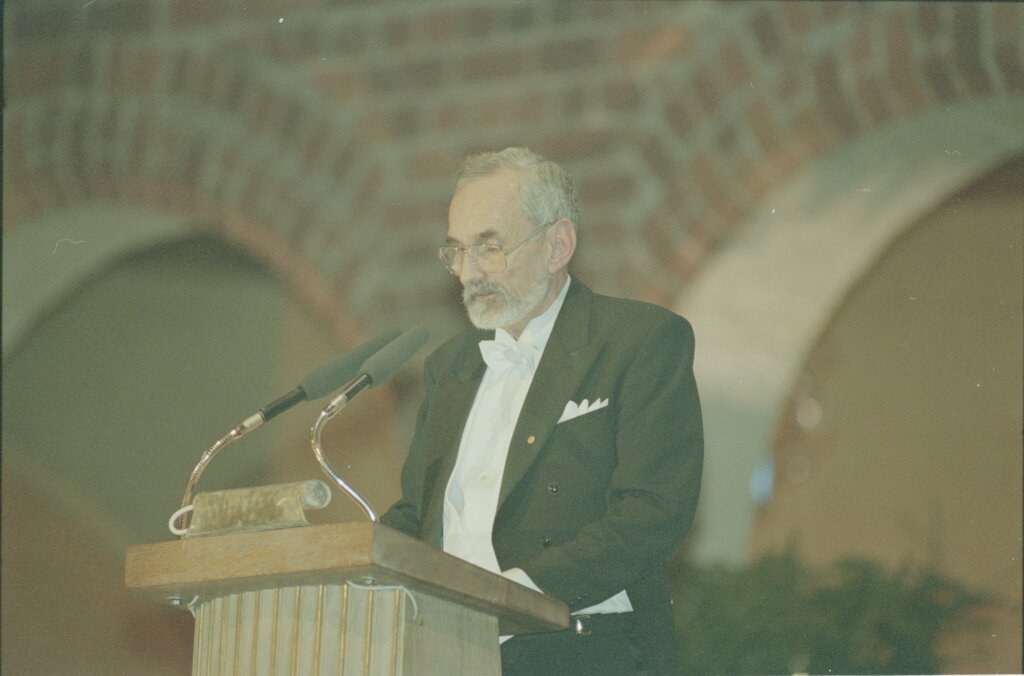Robert F. Curl Jr.
Banquet speech

Robert F. Curl Jr.’s speech at the Nobel Banquet, December 10, 1996
Your Majesties, Ladies and Gentlemen,
Harold Kroto, Richard Smalley and I are deeply grateful for the honors you have given us today. The Nobel Prize is the ultimate celebration of scientific discovery. We are delighted that our contribution in the discovery of the carbon cage molecules that we called the fullerenes is being recognized. I have to make clear that we do not and cannot claim this discovery is ours alone. Two people who are equally responsible, Professor James Heath and Dr. Sean O’Brien, are in this room tonight. There are several others who made important contributions to the fullerene research and deserve to be recognized, most notably Dr. Yuan Lin and Dr. Qing-Ling Zhang, and Professor Frank Tittel. Professor Tittel is also here tonight.
None of us has recovered, or are ever likely to recover, from our astonishment that these beautiful three dimensional molecules are formed spontaneously when carbon vapor condenses under the right conditions, and that we were fortunate enough to discover this amazing fact. This discovery grew out of the union of Richard Smalley’s and my studies of clusters and the apparatus Richard Smalley developed for this purpose with Harold Kroto’s interest in carbon in the interstellar medium. At the outset, none of us had ever imagined these carbon cage molecules. When we looked at carbon, the single astounding carbon sixty peak in the mass spectrum and the circumstances under which it came to prominence admitted no other explanation than the totally symmetric spherical structure, and suddenly a door opened into a new world.
The fullerenes have caused chemists to realize the amazing variety of structures elemental carbon can form from the well-known three-dimensional network that is diamond and the equally well-known flat sheets of hexagonal rings that are graphite to the newer discoveries of the three-dimensional cages that are fullerenes. We have learned that the cages can be extended into perfect nanoscale tubules which offer the promise of electrically conducting cables many times stronger than steel. Or the cages can nestle one inside the other like Russian dolls. Now that we have become more aware of the marvelous flexibility of carbon as a building block chemists may ultimately learn how to place five- and seven-membered rings precisely into a network of hexagonal rings so as to create nano structures of ordered three-dimensional complexity like the interconnecting girders in a steel-frame building.
At this moment there is no commercial product based upon fullerenes, but it is only eleven years since we found they form spontaneously and only six years since Wolfgang Krätschmer and Donald Huffman and their students put these unique compounds into the hands of chemists. We are confident that uses will come probably in materials science with fullerenes as parts of composites and perhaps in medicine. Many scientists around the globe are exploring their unique properties. Perhaps soon one of these groups will make a discovery of a significant use for fullerenes or find a clever way to control the morphology of carbon.
Speaking for Harold Kroto and Richard Smalley, we thank you for the wonderful honors you have bestowed upon us today.
Nobel Prizes and laureates
Six prizes were awarded for achievements that have conferred the greatest benefit to humankind. The 12 laureates' work and discoveries range from proteins' structures and machine learning to fighting for a world free of nuclear weapons.
See them all presented here.
